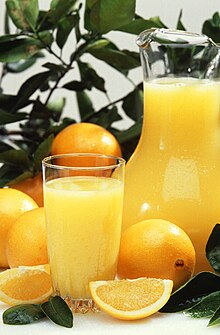orange juice
| Nutritional value per 100 g of orange juice, unsweetened | |
|---|---|
| Calorific value | 178 kJ (42 kcal) |
| water | 89.5 g |
| protein | 0.7 g |
| carbohydrates | 8.7 g |
| - of which sugar | 8.7 g |
| - fiber | 0 g |
| fat | 0.1 g |
| Vitamins and minerals | |
| Vitamin A | 1.3 µg |
| Vitamin B 1 | 60 µg |
| Vitamin B 2 | 10 µg |
| Vitamin B 3 | 250 µg |
| Vitamin B 5 | 160 µg |
| Vitamin B 6 | 127 µg |
| Vitamin B 7 | 0.8 µg |
| Vitamin B 9 | 20 µg |
| vitamin C | 42 mg |
| Calcium | 15 mg |
| iron | 270 µg |
| magnesium | 12 mg |
| sodium | 1.4 mg |
| phosphorus | 16 mg |
| potassium | 142 mg |
| zinc | 120 µg |
| copper | 57 µg |
| manganese | 30 µg |
Orange juice, or orange juice , is a fruit juice that is made by squeezing oranges . In Germany it is often referred to colloquially as orange juice . Orange juice is the most popular juice in the world and represents 50% of the total consumption of fruit juices. Around 12 billion liters of orange juice are consumed around the world every year, i.e. almost 2 liters per capita of the world's population.
A distinction is made between not-from- concentrate juice and fruit juice made from fruit juice concentrate. Orange juice is made durable in the harvesting country (mainly Brazil) after pressing by pasteurization . If the destination country is overseas, for example Europe, it is transported by orange juice tanker and bottled in the destination country by the fruit juice manufacturers. The main part of the orange juice obtained, however, is still processed into orange juice concentrate in the country of production. To do this, first the aromas and then the water are removed from the orange juice under vacuum at low temperatures . This compresses it to around one sixth of its original volume. The concentrate and aroma are cooled and transported to the destination country at 0 ° C. When producing the juice from concentrate, the original concentration of 100% orange juice is restored by adding drinking water.
Orange nectar and orange juice drinks are diluted preparations that consist of portions of orange juice, water and, in some cases, other ingredients such as sugar.
Half of the oranges produced for juice worldwide are harvested in Brazil, which accounts for 80% of world trade in orange juice. On average, 6 billion liters of juice are exported from Brazil every year. Of this, 1.16 million tons are exported as orange juice concentrate. The largest importer is the European Union , which absorbs around two thirds of exports (as of 2011).
Situation in Germany
According to the Fruit Juice and Soft Drinks Ordinance , juice may only be defined as a drink that is 100% made from the fruit juice and the pulp of the corresponding fruit.
To correct a sour taste, orange juice, like other fruit juices, has not been allowed to add sugar since 2012.
In Germany, the annual per capita consumption of orange juice in 2019 was 7.2 liters.
Individual evidence
- ↑ Food table for practice. The little souci specialist herb . Published by the German Research Institute for Food Chemistry, Freising. Edited by Gaby Andersen and Kathrin Soyka. 5th edition. Wissenschaftliche Verlags-Gesellschaft, Stuttgart 2011, ISBN 978-3-8047-2679-6 , pp. 414 .
- ↑ For the situation in Germany see: Fruit Juice and Refreshment Drinks Ordinance .
- ↑ For the situation in Germany, see: Guidelines for soft drinks .
- ↑ Goncalves, AC: The CitrusBR footprint study and the sustainability in the orange juice chain, October 12, 2012, Brussels.
- ↑ http://www.berliner-zeitung.de/serviceinfos/zu-viel-zucker-und-andere-zusaetze--dann-doch-lieber-saft-selber-machen,16928418,17241330.html .
- ↑ https://www.fruchtsaft.de/branche/daten-und-ffekten/ www.fruchtsaft.de

